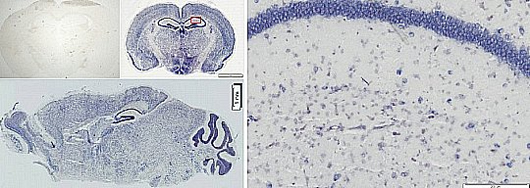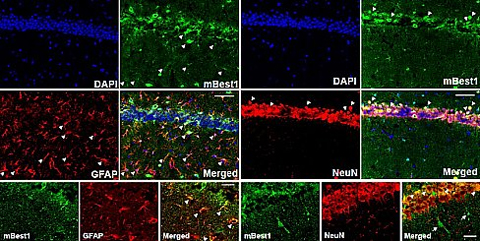Korean scientists identify gene-generating 'anion channel' in Astrocytes
성수 최 2009-12-09 View. 7,274Korean scientists identify gene-generating 'anion channel' in Astrocytes.
Dr. Lee Chang-joon at KIST's Center for Neural Science makes breakthrough Korean scientists have discovered the identity of the gene that generates 'Ca2+-activated anion channel (CAAC)' in Astrocytes. According to the Korea Institute of Science and Technology(President Han Hong-taek) on November 12, Dr. Lee Chang-joon at the Center of Neural Science at the Institute had discovered that the Ca2+-activated anion channel in Astrocytes is induced by a gene called Bestrophin.

(Photo) Bestrophin genes exist in the brain cells, and are generated extensively in astrocytes in particular through a DNA amplification test.
The surface of Astrocytes has various Ca2+-activated anion channels. These channels are said to play important functions in regulating the metabolic activities within cells, but nothing had yet been reported about which gene induces the channel. Along with nerve cells, Astrocytes are an important component of the nerve system. The study used imaging and electro-biological experiment methods.
In short, it identified that anion channels are generated in cultured Astrocytes in mice brains, and brain cross-sections of conditional gene-regulation mice, especially the Hippocampal Astrocytes that exist on the hippocampus. Moreover, it discovered that most anion channels are induced by the emergence of Bestrophin, which had been known as the gene causing a hereditary visual disease called vitelliform macular dystrophy.

(Photo) This picture shows the distribution of Bestrophin generated in mouse brain cross-sections through an experiment called "situ hybridization"(a method for identifying the location, distribution, and degree of emergence of a certain gene using DNA or NRA probes). Bestrophin is seen to be amply generated in the brain overall, and can be especially identified at the hippocampus.

(Photo) Bestrophin genes are generated in astrocytes in mouse brain cross-sections, as presented through an immuno-staining experiment.
Using imaging and electro-biological experiment method.
Dr. Lee explained the achievement as follows: "Astrocytes had been only known for their role in assisting the neural transmission thus far, and were not considered very important. The result of the study is significant because it supports the hypothesis that Astrocytes not only help nerve cells maintain their functions seamlessly but are also related with diverse important metabolic activities, including damage and revival of the nerve system."
He added, "The study is important in that we have laid the foundation for research to identify the roles of anion channels existing in the Astrocytes, and the mechanisms of biological activities within cells; moreover, it has opened up the possibility for the development of a great therapeutic drug for diverse brain diseases related with those functions."
The study was published in the October 14 issue of the Journal of Neuroscience, an official journal published by the Society for Neuroscience in the U.S.
?
Kim Jae-ho
jhkim at kofac.or.kr
[November 24, 2009]
- - - - - - -
Source - ScienceTimes

 Delete Article!
Delete Article!